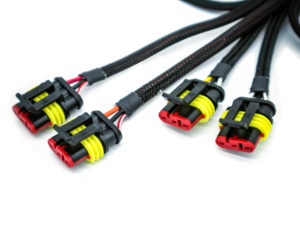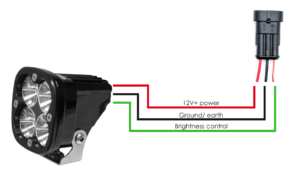Installing the ezCAN on your K1600
Locate your bike's battery and DWA connector
DWA and battery locations.

Remove seats

The alarm connector (DWA) is situated under the rear cowling

The alarm connector (DWA) unplugged

This is a step by step guide to installing the HEX ezCAN on BMW K1600 series bikes. The following bikes are supported in the BMW K1600, F750, F850 & S1000XR series:
DWA and battery locations.

Remove seats

The alarm connector (DWA) is situated under the rear cowling

The alarm connector (DWA) unplugged

Download and install the HEX ezCAN configuration software from the Software page.
Our Software page sets out the process of configuring the installation with the HEX ezCAN configuration software.
Connect your ezCAN to the computer and make sure your unit has the latest firmware.
Determine the channel configuration, see below.

You can secure the ezCAN with the velcro strips provided after the accessories have been plugged in.


The battery is located under the front seat. Route both the ezCAN power supply cables forward, along the motorcycle’s rear sub-frame, to the battery. Disconnect the battery wiring harness terminals from the battery and connect the ezCAN wires to the battery before re-connecting the factory wires.
IMPORTANT NOTE: First, unplug the battery negative wire and only attach it at the end again. This is good practice whenever you work on your bike's electronics.


HEX ezCAN Power supply cables
Note: DWA is the German abbreviation for ‘Diebstahl Warnanlage’ (anti-theft alarm system)
Bike with DWA control unit (Alarm)
Bike without DWA control unit (Alarm)
If your K1600 does not have a DWA system, the end of the wiring harness plug will be covered by a plastic blanking plug containing an alarm-terminating resistor.
IMPORTANT NOTE: Both the male and female ezCAN CAN-Bus terminals must be connected correctly. Do not connect to any other component or to any other part of the motorcycle's wiring harness. If you do, the ezCAN will not function.

ezCAN CAN-Bus connectors
Connect the end of the green wire with one terminal pin to the one-pin terminal on the ezCAN.


The HEX ezCAN kit includes eight stub connectors with male connection terminals. Four of the stub connectors have three wires while the remaining four connectors have two wires.

Three Wire stub connector

Three wire stub connectors

Two Wire stub connectors

If your auxiliary lights have three wires use the three wire stub connectors. If not the two-wire stub connectors must be used for accessories that have power and ground wires only.
If you are not going to use one or more of the power output channels, it is recommended that you install a blanking plug over the unused output. The HEX ezCAN product contains two blanking plugs.
The colour-coding on the output wires must match the colours in the output configuration you select from the HEX ezCAN channel mapping software. Red to red, orange to orange, etc. (Black wire is Battery Negative and the Red, Orange,Yellow and White are the Positive Supply.)


Connect the terminals of the high-power and low-power stub connectors to the correct female terminals on the ezCAN.


Connect the spotlight’s ground wire to the ground wire of the stub connector.
If you are installing spotlights equipped with a third wire for light-intensity control, connect the spotlight control wire to the control wire of the stub connector. If the spotlight only has two wires, use the two wire stub connectors.

Most newly installed accessories can be tested simply with the ignition "ON", but some brake functions will require the bike to be in motion and traveling above a certain speed. For example, emergency braking requires deceleration of more than 21km/h/s (kilometres per hour per second).
SAFETY NOTICE: Test and check your installations and accessories in a safe, controlled environment. Caution is advised at all times. Extra vigilance is required when testing new features or accessories. You do so at your own risk.
DISCLAIMER: HEX ezCAN is not liable for any injury or damage howsoever caused and all products and services are used at your own risk.